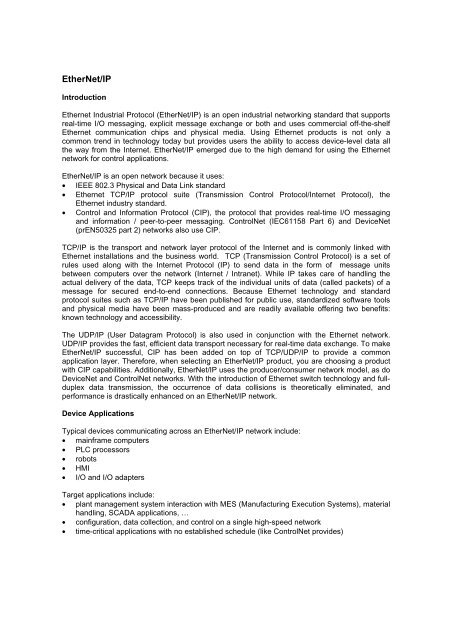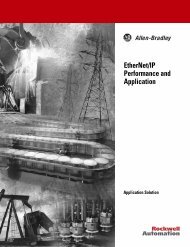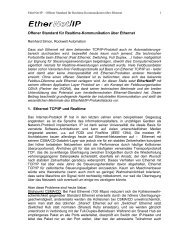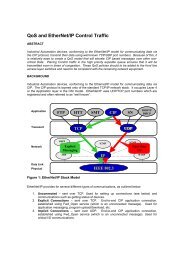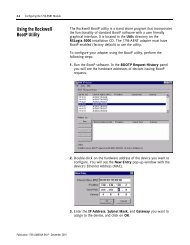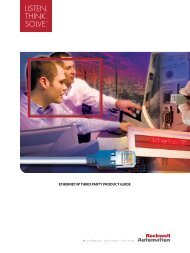EtherNet/IP
EtherNet/IP
EtherNet/IP
Create successful ePaper yourself
Turn your PDF publications into a flip-book with our unique Google optimized e-Paper software.
<strong>EtherNet</strong>/<strong>IP</strong><br />
Introduction<br />
Ethernet Industrial Protocol (<strong>EtherNet</strong>/<strong>IP</strong>) is an open industrial networking standard that supports<br />
real-time I/O messaging, explicit message exchange or both and uses commercial off-the-shelf<br />
Ethernet communication chips and physical media. Using Ethernet products is not only a<br />
common trend in technology today but provides users the ability to access device-level data all<br />
the way from the Internet. <strong>EtherNet</strong>/<strong>IP</strong> emerged due to the high demand for using the Ethernet<br />
network for control applications.<br />
<strong>EtherNet</strong>/<strong>IP</strong> is an open network because it uses:<br />
• IEEE 802.3 Physical and Data Link standard<br />
• Ethernet TCP/<strong>IP</strong> protocol suite (Transmission Control Protocol/Internet Protocol), the<br />
Ethernet industry standard.<br />
• Control and Information Protocol (C<strong>IP</strong>), the protocol that provides real-time I/O messaging<br />
and information / peer-to-peer messaging. ControlNet (IEC61158 Part 6) and DeviceNet<br />
(prEN50325 part 2) networks also use C<strong>IP</strong>.<br />
TCP/<strong>IP</strong> is the transport and network layer protocol of the Internet and is commonly linked with<br />
Ethernet installations and the business world. TCP (Transmission Control Protocol) is a set of<br />
rules used along with the Internet Protocol (<strong>IP</strong>) to send data in the form of message units<br />
between computers over the network (Internet / Intranet). While <strong>IP</strong> takes care of handling the<br />
actual delivery of the data, TCP keeps track of the individual units of data (called packets) of a<br />
message for secured end-to-end connections. Because Ethernet technology and standard<br />
protocol suites such as TCP/<strong>IP</strong> have been published for public use, standardized software tools<br />
and physical media have been mass-produced and are readily available offering two benefits:<br />
known technology and accessibility.<br />
The UDP/<strong>IP</strong> (User Datagram Protocol) is also used in conjunction with the Ethernet network.<br />
UDP/<strong>IP</strong> provides the fast, efficient data transport necessary for real-time data exchange. To make<br />
<strong>EtherNet</strong>/<strong>IP</strong> successful, C<strong>IP</strong> has been added on top of TCP/UDP/<strong>IP</strong> to provide a common<br />
application layer. Therefore, when selecting an <strong>EtherNet</strong>/<strong>IP</strong> product, you are choosing a product<br />
with C<strong>IP</strong> capabilities. Additionally, <strong>EtherNet</strong>/<strong>IP</strong> uses the producer/consumer network model, as do<br />
DeviceNet and ControlNet networks. With the introduction of Ethernet switch technology and fullduplex<br />
data transmission, the occurrence of data collisions is theoretically eliminated, and<br />
performance is drastically enhanced on an <strong>EtherNet</strong>/<strong>IP</strong> network.<br />
Device Applications<br />
Typical devices communicating across an <strong>EtherNet</strong>/<strong>IP</strong> network include:<br />
• mainframe computers<br />
• PLC processors<br />
• robots<br />
• HMI<br />
• I/O and I/O adapters<br />
Target applications include:<br />
• plant management system interaction with MES (Manufacturing Execution Systems), material<br />
handling, SCADA applications, …<br />
• configuration, data collection, and control on a single high-speed network<br />
• time-critical applications with no established schedule (like ControlNet provides)
Architectural Design<br />
Networking Topology<br />
Typically an <strong>EtherNet</strong>/<strong>IP</strong> network uses an active star topology in which groups of devices are<br />
connected point-to-point to a switch as shown in the typical configuration drawing.<br />
The benefit of a star topology is in its support of both 10 and 100M bit/s products. Mixing 10 and<br />
100M bit/s is possible, and most Ethernet switches will negotiate the speed automatically. The<br />
star topology offers connections that are simple to wire, easy to debug and easy to maintain.<br />
<strong>EtherNet</strong>/<strong>IP</strong> is designed to handle large amounts of messaging data, 1500 bytes maximum per<br />
packet. In addition to handling large amounts of data, the <strong>EtherNet</strong>/<strong>IP</strong> speed (10/100M bit/s)<br />
makes that data transmission even more appealing. Because of the wide acceptance of Ethernet<br />
technology throughout the years, the cost per node for Ethernet switches and other Ethernet<br />
physical media is rapidly decreasing. With these characteristics, <strong>EtherNet</strong>/<strong>IP</strong> is becoming a viable<br />
choice for many control applications.<br />
The <strong>EtherNet</strong>/<strong>IP</strong> cabling components provide flexibility in two areas: overall cost and<br />
manufacturer. Due to the large number of third-party vendors, there is a wide selection of media<br />
components and cost considerations. When building a network, people may use many of the<br />
following components: cabling, transceivers, hubs, repeaters, routers, and switches.<br />
Standard twisted-pair and fiber-optic cables are fully functional with <strong>EtherNet</strong>/<strong>IP</strong>. Depending on<br />
the environment, people should consider products that have been proven for industrial<br />
applications. Depending upon the network configuration, an Ethernet hub or switch is appropriate.<br />
A hub is an inexpensive connectivity method that provides an easy method of connecting devices<br />
on information networks (shared Ethernet). A switch reduces collisions and is recommended for<br />
real-time control installations (switched Ethernet). Routers are used to isolate control data traffic<br />
from other types of office data traffic, to isolate information traffic on the plant floor from control<br />
traffic on the plant floor, and for security purposes, i.e., firewalls. Repeaters extend the overall<br />
network cable length. They can also connect networks with different media types.
<strong>EtherNet</strong>/<strong>IP</strong> Transmission Types<br />
The <strong>EtherNet</strong>/<strong>IP</strong> communication protocol above TCP and UDP is called "Control and Information<br />
Protocol" (C<strong>IP</strong>), which was introduced in 1999 for interoperability. The control portion of C<strong>IP</strong> is<br />
used for real-time I/O messaging or implicit messaging. The information portion of C<strong>IP</strong> is used<br />
for message exchange or explicit messaging. These definitions explain the different<br />
transmission types used in the table below.<br />
• Information. Non-time critical data transfers — typically large packet size. Information data<br />
exchanges are short-lived explicit connections between one originator and one target device.<br />
Information data packets use the TCP/<strong>IP</strong> protocol and take advantage of the TCP data<br />
handling features.<br />
• I/O Data. Time-critical data transfers — typically smaller packet size. I/O data exchanges are<br />
long-term implicit connections between one originator and any number of target devices. I/O<br />
data packets use the UDP/<strong>IP</strong> protocols and take advantage of high-speed throughput<br />
capability of UDP.<br />
• Real-time Interlocking. Cyclic data synchronization between one producer processor and<br />
any number of consumer processors. Interlocking data packets use the faster UDP/<strong>IP</strong><br />
protocols and take advantage of high-speed throughput capability of UDP.<br />
ETHERNET/<strong>IP</strong><br />
TRANSMISSION<br />
TYPES<br />
Information Explicit<br />
I/O Data Implicit<br />
Real-time<br />
Interlocking<br />
MESSAGE TYPE DESCR<strong>IP</strong>TION EXAMPLE<br />
Implicit<br />
Tab.1 Transmission Types for <strong>EtherNet</strong>/<strong>IP</strong><br />
HTTP Capability<br />
Non-time-critical<br />
Information Data<br />
Real-time I/O<br />
Data<br />
Real-time Device<br />
Interlocking<br />
Read / Write<br />
data via message<br />
instruction<br />
Control real-time<br />
data from a<br />
remote I/O device<br />
Exchange realtime<br />
data<br />
between two<br />
processors<br />
Most <strong>EtherNet</strong>/<strong>IP</strong> modules have built-in web server capability. The module, network, and system<br />
data information can be reached using any standard web browser, i.e., Internet Explorer or<br />
Netscape.<br />
Among these <strong>EtherNet</strong>/<strong>IP</strong> products various features are available such as:<br />
• read / write data<br />
• read diagnostics<br />
• send e-mail<br />
• edit configuration data<br />
Ethernet I/O<br />
Products are currently available that have Ethernet ports for scanning functionality and products<br />
that have Ethernet ports for adapter functionality to control I/O over an <strong>EtherNet</strong>/<strong>IP</strong> network. One<br />
of the first <strong>EtherNet</strong>/<strong>IP</strong> products for I/O communcation is “ControlLogix” – a programmable Logix<br />
Controller by Rockwell Automation which offers a 10Mbit or 100Mbit <strong>EtherNet</strong>/<strong>IP</strong>. It can serve as<br />
a local bridge to another field bus, can connect to another ControlLogix processor for peer-to-
peer as well as to a remote I/O adapter. This module supports the transfer of real-time I/O data,<br />
processor-to-processor interlocking, and seamless routing of messages between <strong>EtherNet</strong>/<strong>IP</strong>,<br />
ControlNet, and DeviceNet networks. In addition to accommodating the high data transfer rate<br />
and a large number of I/O chassis, the <strong>EtherNet</strong>/<strong>IP</strong> network provides a simple, flexible means of<br />
transferring I/O data.<br />
Features<br />
• Worldwide acceptance of Ethernet products<br />
• Openness of <strong>EtherNet</strong>/<strong>IP</strong> and NetLinx architecture<br />
• Elimination of data collisions through the use of switch technology and full-duplex<br />
transmission<br />
• Support of both 10 and 100M bit/s products<br />
• Products with built-in web server capability<br />
Typical Configuration (Example using Products from Allen-Bradley / Rockwell Automation)
Further available information to <strong>EtherNet</strong>/<strong>IP</strong>:<br />
• http://www.ethernetip.de<br />
• http://www.odvaeuerope.de<br />
• http://www.ab.com/networks


